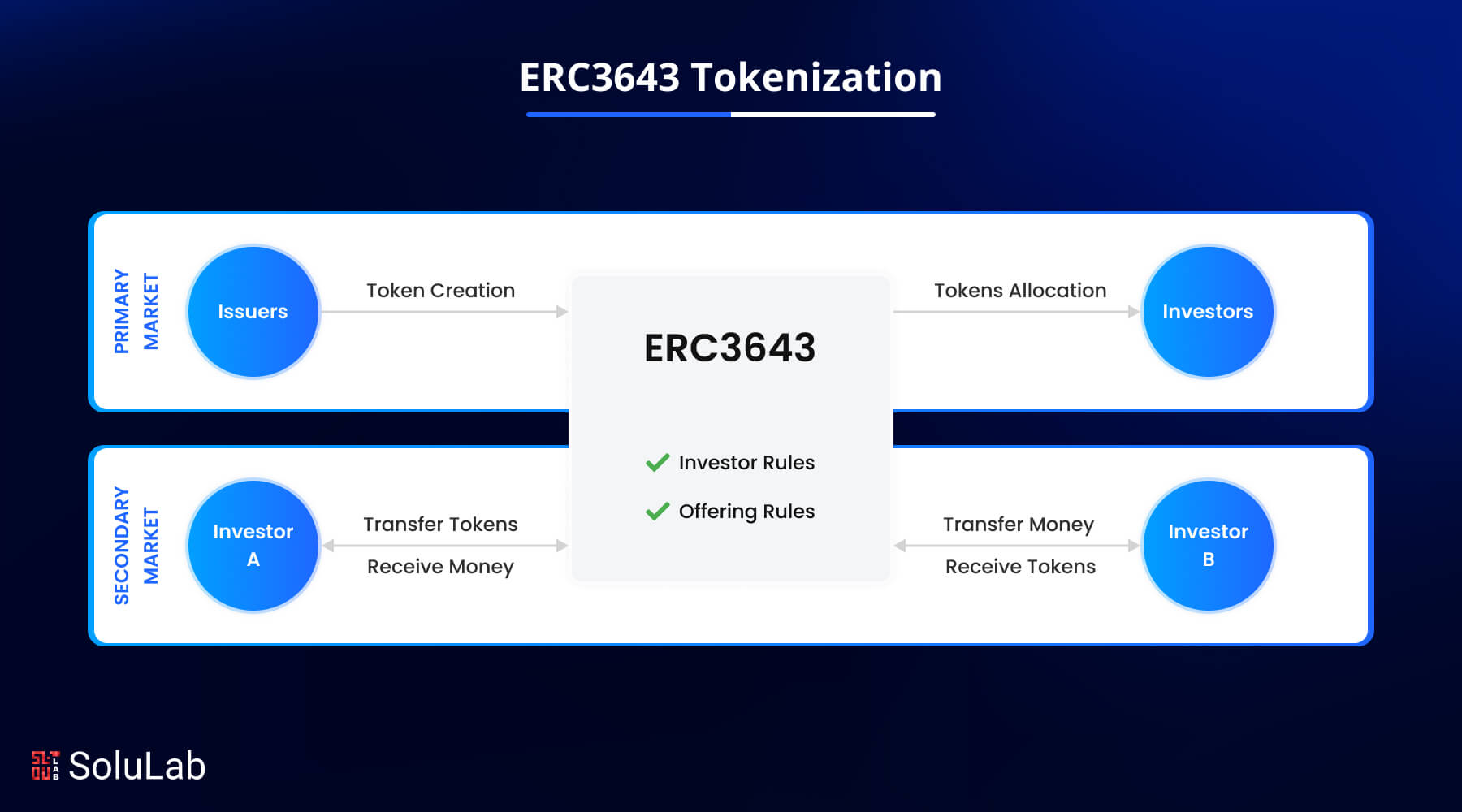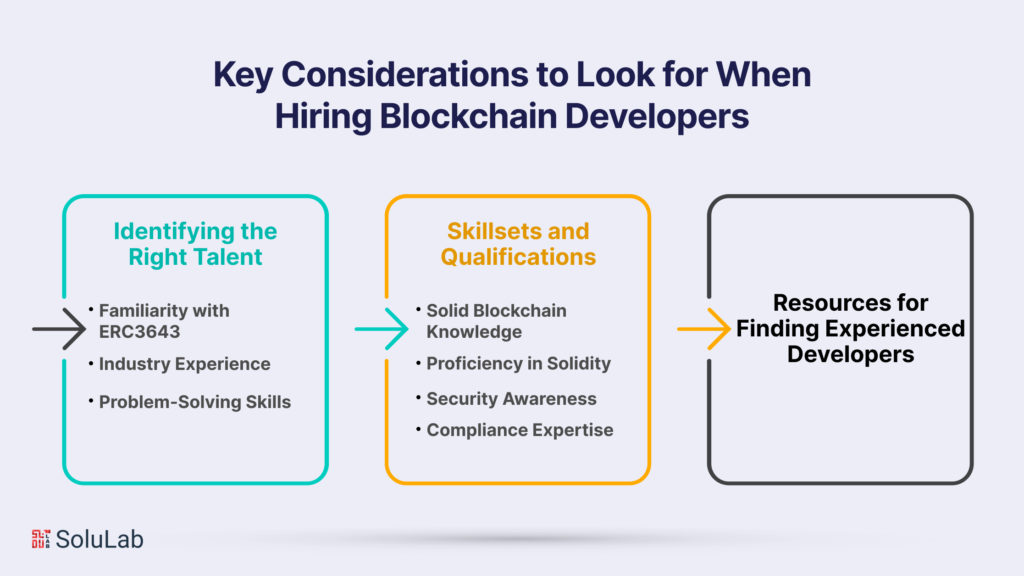
Tokenization is changing how we handle real-world assets, and ERC-3643. Whether it’s real estate, equity, or luxury goods, this Ethereum-based standard is making it easier to represent physical or regulated assets on the blockchain.
But what makes ERC-3643 different from other token standards? It’s designed with compliance in mind, enabling secure, permissioned transfers that align with regulations—something traditional tokens often struggle with.
This blog will walk you through everything you need to know about ERC-3643—from what it is and how it works, to its use cases, benefits. Whether you’re a developer, a startup founder, or just someone curious about blockchain innovation, this comprehensive guide will help you understand how ERC-3643 is shaping the future of tokenized finance and regulated digital assets.
What is ERC3643?
The ERC-3643 token standard simplifies the transfer of securities while adhering to all legal requirements. This makes it the ideal tool for ensuring that RWAs are accessible on the blockchain, which can be readily verified and moved on-chain by ERC-3643 requirements.
ERC-3643 is necessary because the current token standards, ERC-20 and ERC-721, are unable to provide auditable registries, ownership guarantees, and on-chain compliance. These requirements are hard-coded into ERC-3643, which makes on-chain identity verifiable and facilitates the exchange of RWAs because ERC-3643 satisfies all the requirements and compliances that earlier standards were unable to.
Therefore, trading in RWAs is made possible by ERC 3643. ERC-3643 will surely give firms a haven to trade in RWAs, especially in areas like the European Union, where the MiCA bill is cracking down on VASPs.
What are the Benefits of Utilizing ERC3643?
Asset tokenizers should consider ERC3643 due to its many benefits. Here are ERC3643 advantages.
1. Enhanced Security: ERC3643 identity-based permissions tokens boost security. By requiring ONCHAIN ID user identity verification and smart contract compliance, the standard reduces fraud and unwanted access. This safeguards the assets and the tokenized asset ecosystem’s integrity and reputation. Because they trust their investments are safe, investors worry less about breaches and unlawful transfers.
2. Investor Protection: Compliance is key to this protection. ERC3643 restricts tokenized asset market participation to authorized users, reducing the risk of fraud, frauds, and asset mismanagement. Investor confidence increases when they operate in a regulated and secure environment. Investor protection is a legal requirement and a conventional design principle.
3. Compliance with regulations: ERC3643 helps asset issuers comply with relevant rules and regulations because it is designed to match current regulatory frameworks. ERC3643 embeds compliance measures within the token, simplifying a difficult and changing procedure. Issuers can limit legal risks and liabilities and maintain regulatory goodwill by taking this proactive approach.
4. Fractional Ownership: ERC3643 divides expensive assets into smaller, more affordable pieces. This makes investing accessible to more people. Fractional ownership allows people to participate in previously unattainable assets, creating a more inclusive and diverse investing.
How Does ERC3643 Work?
ERC3643, a groundbreaking token standard designed for Real-World Asset (RWA) Tokenization, has gained immense attention in the blockchain ecosystem. Its unique features and seamless integration with Ethereum have made it a prominent choice for various tokenization use cases. In this article, we will explore the inner workings of ERC3643, covering token creation, transfer mechanisms, smart contract integration, and its robust security protocols.
-
Token Creation and Management
ERC3643 facilitates the creation and management of tokens representing real-world assets. These assets can range from real estate properties and fine art to commodities and corporate equity. The token creation process is user-friendly, enabling individuals and entities to tokenize their assets. Users define the asset’s characteristics, which may include ownership, value, and legal details, and then deploy the token on the Ethereum blockchain solutions.
The benefits of ERC3643 in this regard are substantial. It offers asset owners the advantage of fractional ownership, allowing them to divide high-value assets into smaller, tradable units. This enhances liquidity and broadens investment opportunities for a wider range of participants.
-
Token Transfer Mechanisms
ERC3643 tokens can be transferred between Ethereum addresses seamlessly. These tokens leverage Ethereum’s robust infrastructure for transactions, ensuring speed and security. In addition, the fractional ownership aspect empowers users to trade these tokens easily, expanding the market for real-world assets.
The ease of transferring ERC3643 tokens paves the way for enhanced financial inclusion. People worldwide can invest in high-value assets that were once inaccessible. This democratization of investments is one of the key features and uses of ERC3643, making it a powerful tool for a more equitable financial system.
-
Smart Contracts Integration
Smart contracts play a pivotal role in ERC3643. These self-executing contracts are designed to automate and enforce the rules and conditions governing tokenized assets. Asset ownership, transfers, and trading are facilitated through smart contracts, ensuring that all transactions adhere to the predefined guidelines.
The use of smart contracts in ERC3643 leads to increased security and transparency. The benefits of ERC3643’s smart contract integration include reduced counterparty risk, reduced need for intermediaries, and a verifiable history of asset ownership and transfers.
-
Security Protocols in ERC3643
Security is paramount in the ERC3643 standard. Tokenization ERC3643 incorporates rigorous security protocols to protect assets and transactions. This focus on security is especially critical in the world of real-world asset tokenization, where high-value assets are at stake.
The benefits of ERC3643’s security features include robust encryption, multi-signature authentication, and secure key management. These measures ensure that asset ownership is protected, and transactions are tamper-proof, thereby instilling trust among users and market participants.
What are the Key Features of ERC3643 Tokens that Stand Out?

Tokens of ERC3643 are a pivotal component of this innovative token standard, offering a gateway to revolutionize the way assets are represented, traded, and governed on the blockchain. This unique approach is characterized by its focus on regulatory compliance, fractional ownership of high-value assets, and providing a digital representation for tangible real-world assets. In this article, we delve into the tokens of ERC3643, emphasizing their role, advantages, and how they conform to the ERC3643 Token Standard.
-
Digital Representations of Real Assets
ERC3643 tokens serve as digital representations of real assets, bridging the physical and digital realms. These tokens mirror real-world assets, such as real estate, art, or commodities, and render them tradable in a secure, transparent, and decentralized manner.
This digitalization of tangible assets enhances liquidity and accessibility, making it possible for a broader audience to participate in asset ownership and investment.
-
Fractional Ownership of High-Value Assets
ERC3643 tokens facilitate fractional ownership, a groundbreaking concept in the world of high-value assets. By dividing assets into smaller, tradable fractions, this token standard democratizes investment opportunities.
Investors can now own a fraction of a premium property, a masterpiece artwork, or a valuable commodity, spreading the benefits and risks more evenly among stakeholders.
-
Regulatory Compliance and Governance
One of the standout features of ERC3643 tokens is their robust adherence to regulatory compliance and governance standards.
These tokens are designed with built-in functionalities to ensure that issuers, asset owners, and investors adhere to legal requirements, such as KYC and AML. Additionally, they facilitate transparent governance mechanisms, allowing asset owners to define rules, voting mechanisms, and other parameters in line with regulatory guidelines.
-
ERC3643 Token Standard Token ID
Each ERC3643 token is assigned a unique Token ID that distinguishes it within the standard. This Token ID acts as a digital identifier, enabling precise tracking, authentication, and categorization of ERC3643 tokens.
It plays a vital role in ensuring the tokens’ compliance with regulatory standards and their seamless integration into trading platforms and exchanges. The Token ID is a critical element in safeguarding the benefits and integrity of ERC3643 tokens.
Key Considerations for Hiring Blockchain Developers for ERC3643 Projects

ERC3643, the new token standard for Real-World Asset (RWA) Tokenization, requires particular skills to build and manage. Due to ERC3643’s benefits, capabilities, and use cases, these projects have great potential, but hiring the proper blockchain developers is crucial. This comprehensive guide will help you find, evaluate, and work with the top ERC3643 project talent.
A. Identifying the Right Talent
Identifying top blockchain talent is the first step in launching a successful ERC3643 project. Look for developers who possess a deep understanding of blockchain technology companies and, more specifically, the ERC3643 token standard. Key factors to consider include:
-
Familiarity with ERC3643
Seek developers who have experience with ERC3643 or related token standards, as this prior knowledge can expedite project development.
Check Blog Post: Top 10 Real World Applications of Blockchain Technology
-
Industry Experience
Developers with experience in the Real-World Asset Tokenization space are valuable, as they can provide insights into the best practices and potential pitfalls.
-
Problem-Solving Skills
ERC3643 projects often involve complex challenges. Developers who excel at problem-solving and critical thinking are essential.
B. Skillsets and Qualifications
Top blockchain developers for ERC3643 projects should have a diverse skill set that encompasses not only blockchain technology but also aspects of tokenization, asset management, and regulatory compliance. Some key qualifications and skill sets to look for include:
-
Solid Blockchain Knowledge
Developers should be well-versed in blockchain fundamentals, such as consensus mechanisms, smart contracts, and decentralized applications.
-
Proficiency in Solidity
Solidity is the primary programming language for Ethereum-based projects, including ERC3643. Developers should be skilled in writing secure and efficient smart contracts in Solidity.
-
Security Awareness
Security is paramount in the blockchain space. Developers must understand common vulnerabilities and employ best practices to secure ERC3643 tokens.
-
Compliance Expertise
Given the real-world asset focus of ERC3643, developers with knowledge of regulatory compliance and legal aspects can be highly beneficial.
D. Resources for Finding Experienced Developers
One way to find experienced blockchain developers for ERC3643 projects is to explore specialized blockchain development firms. SoluLab is a well-known development company with expertise in blockchain technology. They have a proven track record in building blockchain solutions, which may include ERC3643-based projects.
SoluLab can provide experienced developers who are well-versed in the ERC3643 token standard and can leverage their extensive knowledge of blockchain technology and its applications. This can significantly expedite the development process and reduce the learning curve.
Examples of RWAs Where ERC3643 Can Be Beneficial
Tokenizing real-world assets (RWAs) using the ERC-3643 standard is gaining traction for its strong compliance and security features. Here are some key examples where it can be especially beneficial.
1. Introduction of Tokenized Treasury Bills (T-T-B)
Investors received exceptional returns from traditional T-Bills this year. However, tokenized T-bills kept investors on alert. Tokenized T-Bills have grown 600%Y-o-Y to $700 million in 11 months. These bills have yielded nearly 5.2%YTM in the last five years, outperforming the regular US Treasury Bill, which has yielded only 3.5%.
Tokenized T-Bills are becoming an investment haven. Why? Investors gained transferability and interoperability from ERC-3643 standards, which previous T-bills lacked. They’re saturating the investment ecosystem. The Tokenized-T-Bills’ current performance should lead to an optimistic $4T by 2030 after ERC-3643 standards are introduced. Tokenized Bonds will get $1T. Franklin Templeton’s Franklin OnChain U.S. Government Money Fund(FOBXX) Benji Token has grown to $276M due to the Tokenized-T-Bills sentiment.
These developments have shown that Tokenized T Bills will be the next big thing, and JP Morgan and BOA will drive the trend. T-bills are now freely accessible, interoperable, and transferable to maximize trade-offs thanks to ERC-3643 standards.
2. Tokenized Private Credit
DeFi eased loan access with flash loans and crypto-to-crypto collateralization, but it revealed difficulties to the public. For example, not everyone can handle flash loan shifting between protocols. Even crypto-to-crypto loan collateralization proved too complicated for convenient lending.
Onchain Private Credit beats the competition by using off-chain assets and business income as collateral, enhancing capital efficiency and making loans available to untapped populations. ERC-3643 alone powers these trade-offs, making RWAs accessible in the decentralized ecosystem for better loan collateral inclusion.
Bru Finance, a commodity tokenization platform with over $650m in commodities, has extended $150M to farmers through an off-chain yield mechanism built on ERC-3643 that triggers farmer progress and extends loans based on such data. CiTi Bank, Maersk, and a canal authority are developing the Citi Token Service project to guarantee small business loans and credit finance using ERC 3643 standards and immovable assets as security.
3. CBDCs Bridging TradFi-DeFi Gap
The crypto market has been dissatisfied with stablecoins backed by worthless assets. Many investors still remember Terra USD. CBDCs are closing TradFi-DeFi gaps. DeFi protocols seek to interact with CBDC pilots, and ERC 3643 can make it easy to add RWA to the DeFi ecosystem.
CBDCs can quickly switch DeFi protocols, reducing crypto asset risk. Mariana and other projects are registering their POCs with the Bank of France, the Swiss National Bank, and the Singapore Monetary Authority. Other projects like Project Guardian will support the idea of adopting ERC-3643 standards to introduce RWAs to DeFi and crypto, and backing CBDCs with $16 trillion of global illiquid assets by 2030.
Conclusion
ERC-3643 offers a secure and compliant way to tokenize real-world assets on the blockchain. With built-in identity verification and access control, it bridges the gap between traditional finance and decentralized systems.
Whether you’re a startup, investor, or enterprise, adopting ERC-3643 can improve operations, ensure regulatory compliance, and get new opportunities in asset management. If you’re exploring secure tokenization solutions, ERC-3643 is worth considering for its balance of innovation, transparency, and trust in a decentralized environment.
SoluLab, a leading tokenization development company in the USA, can help you implement ERC-3643-based tokenization solutions tailored to your needs. Get in touch with SoluLab today and bring your assets on-chain with confidence.
FAQs
1. What kind of assets can be tokenized using ERC-3643?
You can tokenize equity, bonds, real estate, commodities, and other regulated financial instruments using ERC-3643.
2. What are the use cases of ERC3643?
ERC3643 can be used for tokenizing a wide range of real-world assets, such as real estate properties, fine art, company shares, commodities, and more. It’s a versatile standard that brings traditional assets into the digital world.
3. Why is compliance important in tokenization?
Compliance ensures that tokenized assets meet legal and regulatory requirements, preventing fraud and enabling institutional adoption.
4. What are the key features of ERC3643 tokens?
ERC3643 tokens are compatible with the Ethereum network and adhere to Ethereum’s ERC-20 and ERC-777 standards. They can represent ownership of real-world assets, support fractional ownership, and provide smart contract functionality for automatic dividend distribution.
5. Which blockchain supports ERC-3643?
ERC-3643 is built on Ethereum but can also be implemented on EVM-compatible chains like Polygon and BNB Chain.
6. How can I use ERC3643 for tokenization?
To use ERC3643, you’ll need the assistance of blockchain developers who are well-versed in the standard. They can create and deploy smart contracts that conform to the ERC3643 standard, enabling the tokenization of real-world assets.





